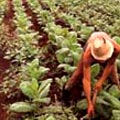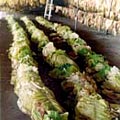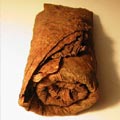Tobacco Production
Tobacco is the leading non food crop in the world. It is chosen by farmers in 100 countries across the world under various climatic and soil conditions to meet the demands of various markets.
Tobacco grows both in tropic and temperate climates. Tobacco is grown from as far north as Canada & Norway. It thrives best in areas with a frost-free growing season of 120 to 170 days, depending on the type of tobacco. Good quality tobacco requires fertile, well-drained, moist soil and warm temperatures. Most types of tobacco are grown in full sun.
Several strains of common tobacco are grown to be used for different tobacco products, they are:
- Virginia tobacco is the main tobacco used in cigarettes; most of it is grown in North Carolina, Georgia, and Virginia.
- Burley tobacco is used in cigarettes and pipes. Several countries, including the United States, Turkey, and Cuba, grow cigar tobacco.
Sensitive plant
Tobacco plants are susceptible to attack from a wide range of insects and bacterial, fungal, and viral diseases. To counteract these problems, tobacco farmers grow strains of tobacco that resist diseases and insects.
Rotation of crops (planting tobacco one year and a different crop in the same field the next year), keeps the population of tobacco pests in check by depriving them of tobacco plants on alternate years.
Before planting, farmers may work a fungicide into the soil to control fungal diseases, such as blue mold and damping-off. They may also fumigate the soil to control nematodes-microscopic worms that infest the roots. Growers also use herbicides to control weeds and insecticides to control insects.
Tobacco cultivation
 Soil, for example, can affect leaf size, texture, and color. Sandy soils tend to produce a relatively large leaf that is light in color and body, fine in texture, and burns with a weak aroma. Heavier soils, which contain silt and clay, tend to produce a small, dark leaf with a heavy body and a strong aroma when burned.
Soil, for example, can affect leaf size, texture, and color. Sandy soils tend to produce a relatively large leaf that is light in color and body, fine in texture, and burns with a weak aroma. Heavier soils, which contain silt and clay, tend to produce a small, dark leaf with a heavy body and a strong aroma when burned.
The annual tobacco cultivation cycle begins with the planting of seeds. Tobacco seeds are extremely small: one million seeds (the potential yield of a single mature plant) weigh about 80 g (about 3 oz) hence they need special care to keep them from drying out once they begin sprouting. To keep young plants watered and weeded, growers sow the seeds in specially prepared seedbeds of fertile, loose soil, rather than directly in the field. One to two months after planting, the growers transplant the seedlings into the field. This is a labor-intensive process called setting the tobacco. As flowers form on the plants bloom, growers remove them in a process called topping, which helps more leaf growth. Tobacco is harvested 70 to 130 days after setting. The harvesting method used depends on the type of tobacco. For some tobaccos, farmers cut whole plants off at the ground and spear them onto a stick about 1 m (3 ft) long, called a tobacco stick. Each stick holds about six plants. For other tobaccos, farmers remove the mature leaves and string them on wires, leaving the rest of the plant to continue growing. Moisture levels at the time of transplanting are critical for establishment of the crop. Only the strongest seedlings are used. Except for oriental, plants are grown on ridges to avoid water logging and to ensure that the fertile topsoil is in the region of the roots. The ridges are built during the subsequent cultivations. Weeds are kept down by hand, mechanical hoeing or spraying.
After eight weeks, the fast-growing plant has its flowers and top leaves removed or "topped" in order to concentrate growth into the leaves (in much the same way as tomatoes are "pinched out"). Harvesting, referred to as "reaping" in some countries, is a continuous activity as the leaves ripen from the base of the plant upwards. In some air-cured crops, this process involves removing a few leaves and then cutting the stalk to cure the remaining leaves intact.
In developing countries, harvesting is by hand and will involve the whole family, while in North America, mechanical harvesting techniques are used. Once harvested, the tobacco leaf is taken for curing by heat, air or wood smoke. The aims are to remove the moisture and vegetable taste of the green leaf and to prepare it for packing and eventual processing.
Most tobaccos (62 per cent in 1993) are flue cured using heat from energy sources such as coal (67.1 per cent), oil and gas (17.2 per cent) and wood (15.7 per cent). These energy sources heat air which is circulated through the racks of tobacco leaf, either by convection or using fans for better control. The treatment for each of the tobaccos is given below:
 Air-cured tobacco is sheltered from wind and sun in a well-ventilated barn, where it is air dried for six to eight weeks. Air-cured tobacco is low in sugar, which gives the tobacco smoke a light, sweet flavor, and high in nicotine. Cigar and burley tobaccos are air cured.
Air-cured tobacco is sheltered from wind and sun in a well-ventilated barn, where it is air dried for six to eight weeks. Air-cured tobacco is low in sugar, which gives the tobacco smoke a light, sweet flavor, and high in nicotine. Cigar and burley tobaccos are air cured.
In fire curing, smoke from a low-burning fire on the barn floor permeates the leaves. This gives the leaves a distinctive smoky aroma and flavor. Fire curing takes three to ten weeks and produces a tobacco low in sugar and high in nicotine. Pipe tobacco, chewing tobacco, and snuff are fire cured.
Flue-cured tobacco is kept in an enclosed barn heated by flues, or pipes, of hot air, but it is not directly exposed to smoke. This method produces cigarette tobacco that is high in sugar and has medium to high levels of nicotine. It is the fastest method of curing, requiring about a week.
Virginia tobacco that has been flue cured is also called bright tobacco, because flue curing turns its leaves gold, orange, or yellow.
Sun-cured tobacco dries uncovered in the sun. This method is used in Greece, Turkey, and other Mediterranean countries to produce oriental tobacco. Sun-cured tobacco is low in sugar and nicotine and is used in cigarettes.
Once the tobacco is cured, workers tie it into small bundles of about 20 leaves, called hands, or use a machine to make large blocks, called bales. The hands or bales are carefully aged for one to three years to improve flavor and reduce bitterness.
Flue curing takes about a week and offers more control of the leaf than other methods of curing for the farmer. The rest of the tobacco crop is dried by natural methods such as air, sun or fire. This is a longer process and takes about six to eight weeks.
Once dried, the tobacco is traditionally tied in bundles or "hands" for sale by auction or direct to a contracted buyer. The leaf is graded and baled for shipment to local manufacturers or to processors all over the world.
Two factors which influence the choice of tobacco by farmers are rapid payment and the fact that tobacco is not affected by quotas. This is in direct contrast to many other traded crops, such as coffee and tea which grow in similar climates.
Tobacco products include:
- Cigarettes, Cigars, and Pipe tobacco, which are smoked
- Snuff, which is inhaled into the nose
- Chewing tobacco, which is chewed but not swallowed
- Tobacco is also used for nicotine products, such as insecticides and medicines to help people quit smoking.
- The nitrogen-rich stalks left after harvesting are used as a fertilizer in tobacco-growing regions.
Processing
 In the first stages of processing, the stems and veins are removed and the leaves are cut into strips. Various tobacco strains are then blended in rotating drums. For example, blends of bright, burley, and oriental tobaccos are used in cigarettes. Moisture-holding substances, such as apple juice or glycerin, and flavorings, such as honey, licorice, or mint, are sometimes added to the blends. The blended tobaccos are then chopped into small shreds.
In the first stages of processing, the stems and veins are removed and the leaves are cut into strips. Various tobacco strains are then blended in rotating drums. For example, blends of bright, burley, and oriental tobaccos are used in cigarettes. Moisture-holding substances, such as apple juice or glycerin, and flavorings, such as honey, licorice, or mint, are sometimes added to the blends. The blended tobaccos are then chopped into small shreds.
The tobacco used in cigarettes and cigars needs to be rolled. Cigarette machines roll tobacco in a special paper that burns slowly and evenly. A filter is often added to collect impurities and make the smoke less harsh to inhale.
Cigars consist of three types of tobacco. The filler, or core, consists of small pieces of leaves, or small whole leaves. The binder holds the filler in place and is, in turn, covered by the wrapper, which is wound spirally, starting at the end that is to be lighted. Although some high-quality cigars are made entirely by hand, most cigars are manufactured by machine.
Chewing tobaccos are generally made from thick grades of leaves to which binders and flavorings are added. Chewing tobacco is formed by pressing the tobacco into blocks known as plugs. Snuff is made by grinding tobacco into fine powder, which is then allowed to ferment for a long period of time. Frequently, snuff is scented with spices, such as jasmine or cloves.



